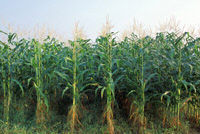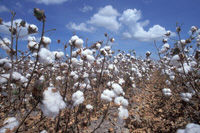Pocket K No. 24: Biotechnology for Green Energy: Biofuels
| |
What are biofuels?
Biofuels are alternative fuels made from plant and plant-derived resources. Biofuels are used mainly for transportation. There are two types of biofuels: bioethanol and biodiesel.
Bioethanol, the principal fuel used as substitute for petrol for road transport vehicles, is mainly produced by the sugar fermentation process of cellulose (starch), which is mostly derived from maize and sugar cane. Biodiesel on the other hand is mainly produced from oil crops such as rapeseed, palm, and soybean (Table 1).
Table 1: Main energy crops worldwide |
||
Country |
Bioethanol |
Biodiesel |
Brazil |
sugar cane |
--- |
United States |
maize |
sobyean |
China |
sweet sorghum |
rapeseed, sunflowerseed |
Germany |
sugar beet |
rapeseed, sunflowerseed |
France |
sugar beet |
rapeseed, sunflowerseed |
Italy |
--- |
rapeseed, sunflowerseed |
Canada |
cereals |
--- |
Thailand |
cassava |
--- |
Spain |
sugar beet |
--- |
Denmark |
--- |
rapeseed, sunflowerseed |
Czech Republic |
--- |
rapeseed, sunflowerseed |
Australia |
cereals, sugar cane |
--- |
Sources: United States Department of Agriculture, United States Department of Energy, the European Commission. |
||
Why have biofuels?
Meeting future energy demands
Energy demand is projected to grow by 50% by 2025, with much of the increase in demand predicted to originate from developing countries. The vast majority of energy is currently derived from fossils fuels, a limited, non-renewable and polluting resource.
Brazil is the world’s leader in biofuels, with 30% of transport fuel currently derived from biomass. In addition, many countries are setting up new initiatives for the production and use of biofuels for transportation (2; Table 2). Switching to biofuels for transportation needs would reduce energy dependency on oil imports and could boost rural development, providing farmers with an additional source of income.
Table 2. Biofuel Production, Top 12 Countries, 2004. Adapted from (2). |
||
Country |
Bioehtanol (billion liters) |
Biodiesel (billion liters) |
Brazil |
15 |
--- |
United States |
13 |
0.1 |
China |
2 |
--- |
Germany |
0.02 |
1.1 |
France |
0.1 |
0.4 |
Italy |
--- |
0.35 |
Canada |
0.2 |
--- |
Thailand |
0.2 |
--- |
Spain |
0.2 |
--- |
Denmark |
--- |
0.08 |
Czech Republic |
--- |
0.07 |
Australia |
0.07 |
--- |
World Total |
31 |
2.2 |
Several countries have set goals for increasing the proportion of biofuels used for transport: the US plans to replace 30% of the liquid petroleum with biomass-derived products by 2025 (3); India has a target to increase the proportion of biofuels from 5% to 20% by 2012 (4); and the European Union targets close to 6% of fuels to be derived from biomass by 2010 (4).
Reducing greenhouse emissions
Despite the uncertainty in understanding something as complex as global climate, there is strong evidence that the emission of greenhouse gases from human activities is resulting in significant global warming. Fossil fuel and electricity consumption are main sources of greenhouse gases. The Kyoto Protocol (5), an international agreement made under the United Nations Framework Convention on Climate Change (UNFCCC) was established with the aim of stabilizing greenhouse gas concentrations in the atmosphere at a level that would prevent dangerous human interference with global climate.
Environmental advantages of biofuels
The main environmental advantage of biofuels stems from the fact that they are carbon-neutral: the carbon dioxide they release upon combustion is initially extracted from the atmosphere during biomass production, resulting in zero net greenhouse gas emissions.
Biofuels also reduce the release of volatile organic compounds, as the addition of ethanol to gasoline oxygenates the fuel mixture so it burns more completely. Ethanol also eliminates the need to add lead. In addition, biofuels are biodegradable and non-toxic, meaning spillages represent far less of a risk than fossil diesel spillages.
The cost of biofuels
The cost of biofuels needs to be estimated not only in terms of energy derived, but also in terms of how much energy/resources are required for the production and distribution of biofuels (6). The production of energy crops requires land, fertilizers, and farm machinery, while the fermentation and distillation of biofuels needs biomass and water. The environmental impacts of producing biomass include increased soil erosion, and pollution related to an increased use of fertilizers, pesticides, and herbicides.
|
Calculating energy efficiency is however very difficult, as we also have to factor in the resources saved by substitution of a renewable energy source for a fossil fuel product, a non-renewable resource. Energy efficiency calculations involve many assumptions on how energy crops are grown, harvested and processed, and also on what resources are saved, which makes these calculations controversial (6).
In addition, the cost of biofuels will also ultimately depend on several parameters that need to be better addressed and are inherently difficult to quantify. Among these are: increased security of supply; effect on climate change; employment generation; and the impact of an expanding bioenergy sector on land demand, and how this will affect alternative land uses, such as food production and biodiversity conservation.
The cost of biofuels is also inextricably linked to the cost of fossil fuels, and is likely to remain so for the next decades. Therefore, currently the main driver for biofuel production is governmental policies. The development of a second generation of perennial, woody energy crops, and the improvement of the efficiencies of biorefineries, will likely shift the economic balance towards more economically competitive applications of biofuels.
Plant Biotechnology and Biofuels
The US Department for Agriculture (USDA) has estimated that one billion dry tons of biomass per year are needed to replace 30% of transportation fuels with biofuels (7). According to an USDA study, this amount of biomass could be produced by 2050, with feasible technological advances while still meeting food, fibre and export demands. The biomass would be mostly derived from crop residues and from the cultivation of perennial energy crops.
The challenge for biotechnology is therefore to substantially increase crop yield, and at the same time develop crops with a suitable set of chemical and physical traits for energy production (8).
Increasing plant yield
|
Plant growth can be improved by increasing the efficiency of light capture during photosynthesis (8, 9). The most successful approaches have involved introducing genes from photosynthetic bacteria into plants, without effecting changes in the level of activity of plant-specific genes. Conventional breeding techniques are therefore unsuitable for the development of crops with more efficient use of solar energy.
Also successful has been the manipulation of genes involved in the metabolism of nitrogen, an essential element in proteins and DNA. Over-expression of a glutamine synthesis gene (GS1) in poplar trees significantly increases tree height (10). Further strategies include extending the growth phase of plants, by reducing seed dormancy, or by preventing or delaying flowering, as plants devote a large proportion of their energy to making reproductive structures which could be harnessed into vegetative growth.
Raising plant protection to abiotic and biotic stress
Abiotic stress is the primary cause of crop loss worldwide, reducing average yields by over 50%. Further losses incur due to attack by pests and pathogens. Developing crops with improved resistance to stress, and equipping plants with enhanced resistance to pests and pathogens, are therefore at the center of numerous crop improvement initiatives, both by conventional breeding and by novel biotechnological methods (11). For example, transgenic rice over-expressing the chloroplastic glutamine synthase gene (GS2) shows increased tolerance to high soil salinity. Such initiatives will have a fundamental impact on plant productivity.
|
Bt cotton, a variety that has been genetically engineered with the insecticidal gene from the soil bacterium Bacillus thurengiensis is a very successful example of a biotech crop developed with improved resistance to pests. The transgene produces a protein that paralyzes the larvae of pest insects, including the cotton bollworm and the Asian and European corn borers. According to a recent study (12), Bt cotton contributed US$ 8.12 billion to the cotton sector in countries adopting the technology (8 in 2005). The economic contribution of Bt cotton stems from both increased yields and reduced production costs.
Optimizing the chemical and physical attributes of biofuel sources
The switch to renewable biomass sources will also require the development of a suite of energy crops tailored with the desired chemical and physical characteristics.
For bioethanol production, attention must shift from plant grains toward corn stovers (dried leaves and stems), trees and perennial grasses, and low-cost agricultural and municipal wastes. Several approaches would improve the efficiency of energy production from biomass sources. As the biosyntheses of cellulose and of lignin are co-regulated, reducing the proportion of lignin in a plant will also increase the proportion of cellulose (13). An alteration of the properties of the cell wall could also be a strategy to facilitate access by key hydrolysing agents for a more efficient release of sugars for fermentation. In addition, research is required to identify new potential biomass sources.
Concluding remarks: the road to biofuels
Biofuels can replace 30% of current transportation energy needs in an environmentally responsible way without affecting global food production with plausible technology developments (8). Current practices, however, do not make biofuels economically competitive, nor optimize energy use and emission characteristics.
|
For biofuels to play an important role in meeting future energy needs, a multidisciplinary approach is required, in which the activities of biologists, agronomists, engineers, energy experts and policy specialists are integrated. In addition to developing specific high-yielding energy crops, the impact, efficiency and sustainability of biorefinery facilities need to be improved. Research is required to enhance the infrastructure for the development of biofuels (including transport, distribution, and production chain), in order make the production of biofuels economically sustainable. Commercialization and policy support are critical for success.
Socio-economic concerns, such as land management practices and the choice of biomass source, should be carefully addressed so that biofuel production does not negatively impact either food production or the preservation of biodiversity.
Equally important are studies to obtain a clear diagnosis of the environmental impact of specific biofuels, in terms of combustion emissions, which vary according to the specific biofuel used; of energy inputs required for the manufacture of biofuels; and in terms of the environmental footprint of fertilizers and herbicides used during the production of energy crops.
| |
References:
- Advanced Energy Initiative. 2006. U.S. Department of Energy. http://www.whitehouse.gov/stateoftheunion/2006/energy/index.html
- Renewables 2005: Global Status Report. Notes and References Companion Document. Renewable Energy Policy Network for the 21st Century. http://www.ren21.net/globalstatusreport/RE2005_Notes_References.pdf
- National Mission on Bio-Fuel. The Energy and Resources Institute of India. http://www.teriin.org/projects/ES/jatropha.pdf
- EU Strategy for Biofuels. European Commission. 2006. http://ec.europa.eu/comm/agriculture/biomass/biofuel/index_en.htm
- Kyoto Protocol to the United Nations Framework Convention on Climate Change. http://unfccc.int/resource/docs/convkp/kpeng.pdf
- Harvesting the Potential of BIOMASS. 2005.David J. Tenenbaum. Environ. Health Perspect. 2005 November; 113(11): A750-A753.
- Biomass as feedstock for a Bioenergy and Bioproducts Industry: the Technical Feasibility of a Billion-Ton Annual Supply. 2005. United States Department of Agriculture (USDA) and United States Department of Energy (DOE).
- The Path Forward for Biofuels and Biomaterials. 2006. Ragauskas, A.J., et al. Science 311: 484-489.
- Enhancing crop yield in Solanaceous species through the genetic manipulation of energy metabolism. 2005. Nunes-Nesi, A. et al.. Bioch. Soc.Trans. 33: 1430-1434.
- Improved growth in a field trial of transgenic hybrid poplar overexpressing glutamine synthetase. 2004. Jing, Z. P. et al. New Phytologist 164: 137-145.
- Recent advances in engineering plant tolerance to abiotic stress: achievements and limitations. 2005. Vinocur, B. & Altman, A. Curr. Op. Biotech.16:123-32.
- GM Crops: The Global Economic and Environmental Impact - The First Nine Years 1996-2004. 2005. Graham Brookes and Peter Barfoot. AgBioForum Vol 8, Number 2 & 3, Article 15.
- Combinatorial modification of multiple lignin traits in trees through multigene cotransformation. 2003. Li, L. et al. PNAS 100: 4939-4944.




